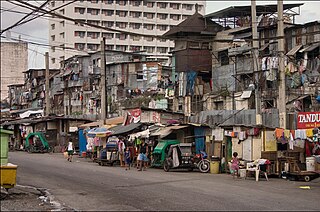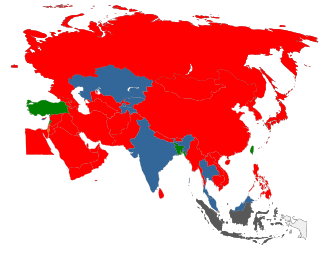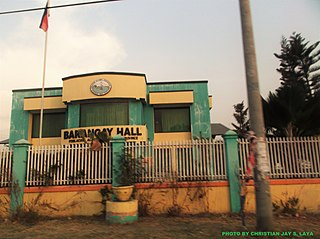Related Research Articles

Valenzuela, officially the City of Valenzuela, is a 1st class highly urbanized city in Metropolitan Manila, Philippines. According to the 2015 census, it has a population of 620,422 people.

San Remigio, officially the Municipality of San Remigio, is a 3rd class municipality in the province of Antique, Philippines. According to the 2015 census, it has a population of 31,935 people.

Pamplona, officially the Municipality of Pamplona, is a 3rd class municipality in the province of Negros Oriental, Philippines. According to the 2015 census, it has a population of 37,596 people.

Dulag, officially the Municipality of Dulag, is a 3rd class municipality in the province of Leyte, Philippines. According to the 2015 census, it has a population of 47,300 people.

Cauayan, officially the Municipality of Cauayan, is a 1st class municipality and the largest settlement in the province of Negros Occidental, Philippines. According to the 2015 census, it has a population of 102,165 people.

Pandan, officially the Municipality of Pandan, is a 4th class municipality in the province of Antique, Philippines. According to the 2015 census, it has a population of 34,333 people.

Cabanglasan, officially the Municipality of Cabanglasan, is a 3rd class municipality in the province of Bukidnon, Philippines. According to the 2015 census, it has a population of 33,997 people.
Urban Health Resource Centre (UHRC) is a non-government organization that works towards socio-economic empowerment, improved quality of life, health, nutrition, well-being and empowered social organization among disadvantaged urban communities through – (i) demand-supply improvement, community-provider linkages, and demonstration programs that use a consultative and partnership based approach, (ii) technical support to government and non-government agencies and (iii) research, advocacy and knowledge dissemination. The UHRC's demonstration programs utilize community organizing to establish women's community groups consisting of slum-dwelling women who advocate for community-level infrastructure improvements.
International Community for the Relief of Suffering and Starvation (ICROSS) is an international non-governmental organisation that provides health and development services for pastoral communities in East Africa.

According to a 1998 report titled "Situation of the Youth in the Philippines", there were about 1.5 million street children in the Philippines.

In response to the Millennium Development Goals' focus on maternal and child health, the Philippines began the National Demographic and Health Survey in 1968 to assess the effectiveness of public health programs in the country.
Officially local government in the Philippines, often called local government units or LGUs, are divided into three levels – provinces and independent cities; component cities and municipalities; and barangays. In one area, above provinces and independent cities, is an autonomous region, the Autonomous Region in Muslim Mindanao. Below barangays in some cities and municipalities are sitios and puroks. All of these, with the exception of sitios and puroks, elect their own executives and legislatures. Sitios and puroks are often led by elected barangay councilors.
A community health worker (CHW) is a member of a community who is chosen by community members or organizations to provide basic health and medical care within their community, and is capable of providing preventive, promotional and rehabilitation care to that community. Other terms for this type of health care provider include lay health worker, village health worker, community health aide, community health promoter, and health advisor.
The Kababaihan Gabay ng Bayan - KAGABAY, means "women supporting the country" in Filipino. KAGABAY is a non-government, non-profit, social development organization. It was set up to address poverty reduction through the social, political and economic empowerment of women in urban poor and resettlement communities. With its motto: “Kababaihan Para Sa Kababaihan", KAGABAY aims to contribute to the achievement of the country’s Millennium Development Goals through the empowerment of women that will enable them to address the multi‐faceted dimensions of poverty within their communities.

Prostitution in Laos is regarded as a criminal activity and can be subject to severe prosecution. It is much less common than in neighbouring Thailand. Soliciting for prostitution takes place mainly in the city's bars and clubs, although street prostitution also takes place. The visibility of prostitution in Laos belies the practice's illegality. UNAIDS estimates there to be 13,400 prostitutes in the country.
A barangay hall is the seat of local government for the barangay, the lowest elected administrative division of the Philippines, below that of a Philippine city or Philippine municipality. The barangay captain, the head of the barangay government, will often hold office there. The elected barangay council, the Sangguniang Barangay, will also hold its meetings there.
Mental health is defined as "a state of well-being in which every individual realizes his or her own potential, can cope with the normal stresses of life, can work productively and fruitfully, and is able to make a contribution to her or his community". The World Health Organization emphasized the importance of mental health by including it in their definition of health as "a state of complete physical, mental and social well-being and not merely the absence of disease or infirmity."

Poblacion is an urban barangay in the Municipality of Alabel, Sarangani Province, Philippines. According to 2010 Census, it has a population of 19,689.

Abortion in Kenya is prohibited with the exception of certain circumstances including danger to the life and health of the expectant mother, and rape. Unsafe abortions are a major cause of deaths and health complications for women in Kenya.
Since 2000, Rwandan reproductive health has taken numerous precautions to prevent maternal and newborn deaths among many other national health improvements. From 2006 on, major changes began in rural areas to provide community-based health insurance.
References
- 1 2 Red Cross. Philippines: Health. Archived May 12, 2012, at the Wayback Machine Accessed November 8, 2011.
- ↑ Lakshminarayanan, Rama (May 2003). "Decentralisation and its implications for reproductive health: the Philippines experience". Reproductive Health Matters. 11 (21): 96–107. doi:10.1016/s0968-8080(03)02168-2. ISSN 0968-8080. PMID 12800707.
- ↑ Philipinnes Department of Health. Archived January 22, 2009, at the Wayback Machine
- ↑ "Republic Act 7883 | Philippine Commission on Women". pcw.gov.ph. Archived from the original on February 6, 2018. Retrieved February 6, 2018.
- ↑ Inobaya, Marianette T.; Chau, Thao N.; Ng, Shu-Kay; MacDougall, Colin; Olveda, Remigio M.; Tallo, Veronica L.; Landicho, Jhoys M.; Malacad, Carol M.; Aligato, Mila F. (January 2018). "Mass drug administration and the sustainable control of schistosomiasis: Community health workers are vital for global elimination efforts". International Journal of Infectious Diseases. 66: 14–21. doi: 10.1016/j.ijid.2017.10.023 . ISSN 1878-3511. PMID 29128644.
- ↑ Basics Support for Institutionalizing Child Survival Project. Newborn Health in the Philippines. Arlington, Virginia, June 2004. Accessed November 8, 2011.
- ↑ Goodwin, Nicholas (July 2, 2014). "Change agents make residents feel safer about dengue fever in the Philippines". Tulodo. Retrieved July 2, 2014.
- ↑ Espino, Fe; Marco, Jesusa; Salazar, Nelia P.; Salazar, Ferdinand; Mendoza, Ysadora; Velazco, Aldwin (December 2012). "Community-based dengue vector control: experiences in behavior change in Metropolitan Manila, Philippines". Pathogens and Global Health. 106 (8): 455–461. doi:10.1179/2047773212Y.0000000061. PMC 3541901 . PMID 23318237.
- ↑ World Bank (2001). Filipino Report Card on Pro-poor Services. Washington DC: East Asia and the Pacific Region Report Number 22181 – PH, Environment and Social Development Sector Unit.
- ↑ Ross, Allen G. P.; Olveda, Remigio M.; McManus, Donald P.; Harn, Donald A.; Chy, Delia; Li, Yuesheng; Tallo, Veronica; Ng, Shu-Kay (January 2017). "Risk factors for human helminthiases in rural Philippines". International Journal of Infectious Diseases. 54: 150–155. doi: 10.1016/j.ijid.2016.09.025 . ISSN 1878-3511. PMID 27717859.
- ↑ Azfar, Omar; Gurgur, Tugrul (July 1, 2008). "Does corruption affect health outcomes in the Philippines?". Economics of Governance. 9 (3): 197–244. doi:10.1007/s10101-006-0031-y. ISSN 1435-6104.